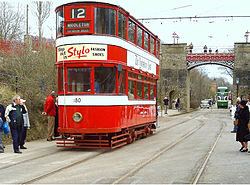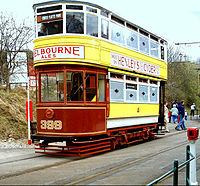Difference between revisions of "National Tramway Museum"
(Created page with "{{Infobox building |name=National Tramway Museum |county=Derbyshire |picture=Old fashioned tram 700.jpg |picture caption=Traditional street setting in the museum |os grid ref=...") |
(No difference)
|
Latest revision as of 12:33, 5 July 2021
| National Tramway Museum | |
|
Derbyshire | |
|---|---|
 Traditional street setting in the museum | |
| Type: | Museum |
| Location | |
| Grid reference: | SK345548 |
| Location: | 53°5’21"N, 1°29’11"W |
| History | |
| Museum | |
| Information | |
The National Tramway Museum (also known as the Crich Tramway Village) is a tram museum located at Crich in Derbyshire. The museum contains over 60 (mainly British) trams built between 1873 and 1982 and is set within a recreated period village containing a working pub, café, old-style sweetshop and tram depots.
The museum's collection of trams runs through the village-setting with visitors transported one-mile out into the local countryside and back. The museum is operated by the Tramway Museum Society, a registered charity.[1]
Contents
History of the museum
History of the site
George Stephenson, the great railway pioneer, had a close connection with Crich and the present (2008) tramway follows part of the mineral railway he built to link the quarry with Ambergate.
While building the North Midland Railway from Derby to Rotherham and Leeds, Stephenson had found rich coal seams in the Clay Cross area of north-eastern Derbyshire and he saw a new business opportunity. Crich was already well known for the quality of the limestone and Stephenson recognised that he could use the local coal and limestone to produce burnt lime for agricultural purposes, and then utilise the new railway to distribute it. Cliff Quarry, where Crich Tramway Village is now located, was acquired by Stephenson's company and to link the quarry with the limekilns he had built alongside the new North Midland Railway at Ambergate, Stephenson constructed a 1-metre gauge line - apparently the first metre gauge railway in the world. Stephenson was born in Wylam in Northumberland in 1781, but he lived the last 10 years of his life in Chesterfield, often bringing visitors to Crich to see the mineral railway and take refreshment in one of the village inns. He died in 1848 and is buried in Holy Trinity Church, Chesterfield. Stephenson's railway soldiered on for many years.
Tramway Museum Society
In the period after the Second World War, when most of the remaining British tramways were in decline or actually closing, the first event in the history of the National Tramway Museum took place. A group of enthusiasts on a farewell tour of Southampton Tramways in August 1948 decided to purchase one of the open top trams on which they had ridden. For the sum of £10 they purchased number 45 – now included in collection at the museum. From this purchase grew the idea of a working museum devoted to operating tramcars. From the original group developed the Tramway Museum Society, established in 1955, incorporated as a company limited by guarantee in 1962, and recognised as an educational charity in 1963. Over the years, the society has drawn its members from people of all age groups and all sectors of the community, working together in different ways to create the tramway museum.
Acquisition of the site
After a sustained search across the country, in 1959 the society's attention was drawn to the then derelict limestone quarry at Crich in Derbyshire: members of the Talyllyn Railway Preservation Society were recovering track from Stephenson's mineral railway for their pioneering preservation project in Merionethshire. After a tour of the quarry, members of the society agreed to lease – and later purchase – part of the site and buildings. Over the years, by the efforts of the society members, a representative collection of tramcars was brought together and restored, tramway equipment was acquired, a working tramway was constructed and depots and workshops were built. Recognising that tramcars did not operate in limestone quarries, the society agreed in 1967 to create around the tramway the kind of streetscape through which the trams had run and thus the concept of the Crich Tramway Village was born. Members then turned their attention to collecting items of street furniture and even complete buildings, which were then adapted to house the Museum's collections of books, photographs and archives.
Timeline
- 1963 - First horse tram service[2]
- 1964 - First electric tram service
- 1968 - First Grand Transport Extravaganza held, in what was to become an annual event[3]
- 1969 - Opening of purpose built workshops
- 1975 - The Duke of Gloucester become Patron of the Society
- 1978 - Opening of scenic tramway to Wakebridge by Secretary of State for Employment
- 1982 - First phase of museum library opened
- 1985 - Museum loans trams to Blackpool for Electric Tram Centenary
- 1988 - Museum loans trams for Glasgow Garden Festival
- 1990 - Museum loans trams for Gateshead Garden Festival
- 1991 - Exhibition Hall inaugurated
- 1992 - Bowes-Lyon Bridge opened by Minister of State for Transport
- 1995 - The Secretary of State for National Heritage announces that the Museum has been included in the first 26 museums to be designated due to the outstanding nature of their collections
- 1997 - First AccessTram for visitors with disabilities
- 2002 - Opening of Workshop Viewing Gallery
- 2003 - Library Reading Room and Archives Store opened by the Duke of Gloucester
- 2004 - Woodland Walk and Sculpture Trail inaugurated by the Dowager Duchess of Devonshire
- 2007 - Leeds 345 wins the Best Self-Propelled Vehicle in the Heritage Railway Association Carriage & Wagon Awards, after its three-year restoration and return to service in 2004
- 2010 - Opening of new "Century of Trams" exhibition in main Exhibition Hall
- 2011 - Opening of refurbished George Stephenson Workshop, which now contains an education suite on the ground floor and a brand new exhibition on the upper floor which connects over a bridge to the Workshop Gallery
- 2014 - Passengers able to alight at Glory Mine for the first time
Tramcar fleet
The museum has over 60 tramcars from locations such as Berlin, Blackpool, Chesterfield, The Hague, Derby, Douglas, Dundee, Edinburgh, Gateshead, Glasgow, Grimsby, Halle (Germany), Howth, Johannesburg, Leeds, Leicester, Liverpool, London, New York, Newcastle, Oporto, Paisley, Prague, Sheffield, Southampton and Sydney. The majority of the trams at Crich are double-decker trams built between 1900 and 1930,[4] and several have open tops. There are a few trams in the collection that were built after the Second World War, and these give an idea of how the British tram industry might have developed if services had not declined.
Every operating day, the museum selects between two and four trams and operates them over its line to Glory Mine, via Wakebridge. In addition, there is a 1969 Berlin tram which has been converted into an "Access Tram", complete with wheelchair lift, which allows visitors with disabilities to travel the line.
Operation of the Tramway
The museum's overhead wire system has been built so that trams with any type of current collection can be used. The museum currently houses trams with trolley poles, bow collectors and pantographs.
Other forms used to demonstrate how current can be collected:
- Conductors set in steel troughs under the roadway, as used in Blackpool, and represented in Crich with Number 4.
- The stud contact system, as demonstrated with a dummy stud between the rails in the yard. This is the only known example of this form remaining, and is from Wolverhampton.
In the media
The museum has been used as a filming location, for cinema and television:
- Sightseers (2012)
- Women in Love (opening scene)
The museum also features heavily in the John Shuttleworth song "Dandelion and Burdock".
The museum possesses the only remaining Mk2 police box, which formed the basis for the design of the TARDIS from Doctor Who.
Pictures
Outside links
| ("Wikimedia Commons" has material about National Tramway Museum) |
- The National Tramway Museum
- Topical pictures of the Museum
- The Tram Centre
- Photographs and Information from Strolling Guides
- Tram Travels: Crich Tramway Village
References
- ↑ The Tramway Museum Society - Registered Charity no. 313615 at the Charity Commission
- ↑ "Derbyshire tram museum at Crich celebrates 50 years". BBC News. 8 July 2013. https://www.bbc.co.uk/news/uk-england-derbyshire-23200486.
- ↑ Brooks, Donald (August 2019). "Quarry Railway with a Difference". Narrow Gauge World (Warners Group Publications Plc): pp. 23–25.
- ↑ "Crich Tramway Village". British Trams Online. http://www.britishtramsonline.co.uk/crich.html.












